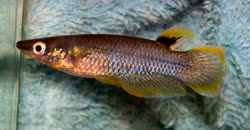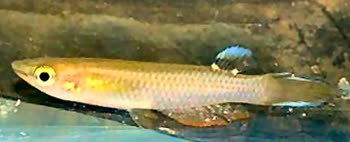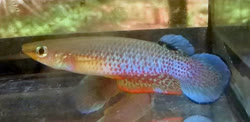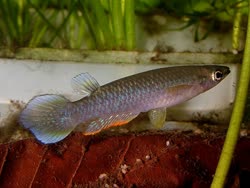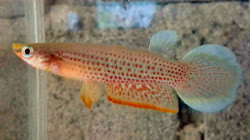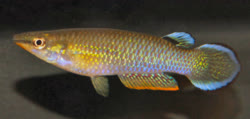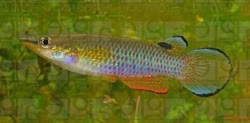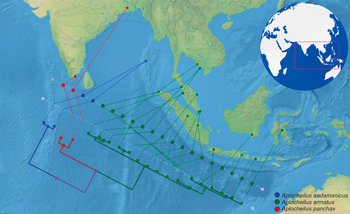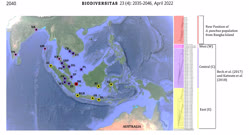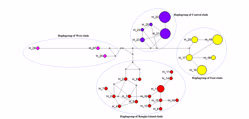|
|
The true A. panchax is found only in the Ganges and the Bengal basin of Eastern India and Western Bangladesh. All the of other locations from West and Cental India and through out the east are A. armatus. See discussion below.
"A. panchax, the species under present study, was reported to have
n=18 and 2n=36 chromosomes by the same author (SCHEEL 1966, 1972)
in the Thailand population while the present findings in the India population
of the same species differed in having n = 19 and 2n = 38 chromosomes." [1978 Khuda-Bukhsh]
In studies from 1966 to 1972 Scheel found the Karyotype of PAN was n=18, 2n=26 in a population from Thailand. In 1978Khuda-Bukhsh found PAN to have n=19, 2n=38. After further analysis Beck in 2017 using molecular data identified 3 clades with PAN. In 2022 Mustikasari identified a unique clade from Banka Island in Indonesia. The name PAN is restrices to those fish from the Ganges, Bengal Basin and Western Bangladesh. A. andamans is found only in the Andamans Islands. The three other clades scatered around Indo-Asia belong to three different clades within A. Armatus. "Purpose of this experiment was to study on distribution and cytogenetics study of Aplocheilus panchax. Ten specimens of A. panchax 2.5-3.5 mm in SL, were used. An observation of mitotic metaphase chromosome prepared from gill, intestine and kidney tissue by the Uwa and Ojima's method (1981) were made. Levan et al.,'s method of chromosome classification was employed. The findings were as follows: 1) Apocheilus (sic) panchax were widely distributed in the Mae Nam Choa Phraya Basin. 2) The diploid chromosome number of A. panchax was 40. The Karyotype consisted of 4 paires of metacentric, 2 pairs of submetacentric, and 14 pairs of acrocentric chromosomes. The arm number was 52. These results will be useful for cytotaxonmy of fishes." [1992 Magtoon] Esox panchax (now assigned to the genus Aplocheilus) was described by Hamilton (1822; p 211) from the ditches and ponds of Bengal (present-day Bangladesh and parts of the state of West Bengal, India). The name A. panchax has been applied to many species of killifishes found across the Indian subcontinent and South-East Asia, but with suggestions that several species are likely to be confused under this name (Kottelat, 2013); and that the distribution of A. panchax sensu stricto, is likely to be restricted to the Gangetic delta and the eastern coastal plains of India (Costa, 2008). However, recent phylogeographic analyses have revealed that A. panchax is widely distributed in South and South-East Asia (Beck et al., 2017; Dahruddin et al., 2017), and comprises of three major mitochondrial clades/lineages (Beck et al., 2017). In 2022 Mustikasari found another clade on Bangka Island. As of writing in 2024 the impact on aquarist is that the fish circulating as A. panchax in the hobby is probably not, unless it came from the Bengal area of India for that is the true A. panchax. All the others fall into three other clades, central "Central" and "East" clades from Beck and the Banka Island clade from Mustikasari. For now, these are all A. armatus while the true A. panchax is from ther Bengal area. There is a giant relic form of this fish found in the Andaman Islands, A. adamandicus (= AND) as well. These fish differ in the number of scales and fin rays and by chromosome numbers which are only a few off, no sigh of polyploidy is exhibited. Is it possible to tell these apart? Maybe in some cases. These fish come in all color fins - white, yellow, orgnage, red and blue and in combinations of these. As of this writing the author has never seen one of these from Bengal that did not have all solid orange fins. A high preponderance of the blue finned fish are from Thailand and surrounding areas and some of the Thai populations of these are the most colorful of all with large red dots on the side, subdued in other forms, and bright powder blue that look nothing like the silvery fish with white fins seen in old aquarium books. The rest? Who knows? Magtoon 1992 Distribution and cytogenetics of killifish, aplocheilus panchax (Hamilton-Buchman) from the central, Thailand [1992] Wichian Magtoon http://agris.fao.org/agris-search/search.do?recordID=TH2002000408 Khuda-Bukhsh 1978 Chromosomes in three species of fishes, Aplocheilus panchax (Cyprinodontidae), Lates calcerifer (Percidae) and Gadusia chapra (Clupeidae). http://sci-hub.io/10.1080/00087114.1979.10796783
|
